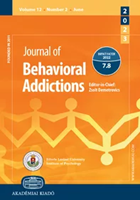How expected and experienced reward and relief contribute to gaming-related mental imagery and gaming frequency in daily life: Testing a dual pathway hypothesis
How expected and experienced reward and relief contribute to gaming-related mental imagery and gaming frequency in daily life: Testing a dual pathway hypothesis
Author(s): Annika Brandtner, Silke M. Müller, Matthias BrandSubject(s): Media studies, Neuropsychology, Personality Psychology, Behaviorism, Substance abuse and addiction, Social Informatics
Published by: Akadémiai Kiadó
Keywords: desire thinking; gaming disorder; gaming frequency; gratification/compensation; sensory imagery; use expectancies;
Summary/Abstract: Research on the development of gaming disorder assumes that the quality of reinforcement learning as well as the content of use expectancies are initially rewarding in the early stages of the addictive behavior and becomes steadily more compensatory in the later stages. This assumed transition could be reflected in gaming-related mental imagery as well as the decision to play videogames in daily life. Methods: We recruited 127 individuals who play videogames. Following a strict diagnostic procedure, individuals were either classified as showing casual or at-risk gaming patterns. The experience and expectancy of reward and relief were assessed in the laboratory, followed by a 14-day ambulatory assessment asking for gaming-related mental imagery intensity and playing frequency. Besides group differences, we tested a gratification and a compensation pathway in a structural equation model among groups separately. Results: Results indicate that mental imagery and playing frequency as well as reinforcement processes and use expectancies are heightened among individuals showing at-risk gaming patterns as compared to casual gaming patterns. Gaming-related mental imagery was only predicted by compensation among individuals showing casual gaming patterns, and we found no significant predictions for daily gaming frequency in any of the models. Discussion and conclusions: The results implicate that individuals with at-risk gaming patterns might hold stronger learned reinforcement contingencies. Daily usage seems unaffected by these contingencies, possibly indicative of habitualized behaviors. Additionally, the results provide some support for the consideration of imaginal desire thoughts as a specific coping mechanism in the context of gaming behaviors.
Journal: Journal of Behavioral Addictions
- Issue Year: 12/2023
- Issue No: 3
- Page Range: 775-785
- Page Count: 11
- Language: English

